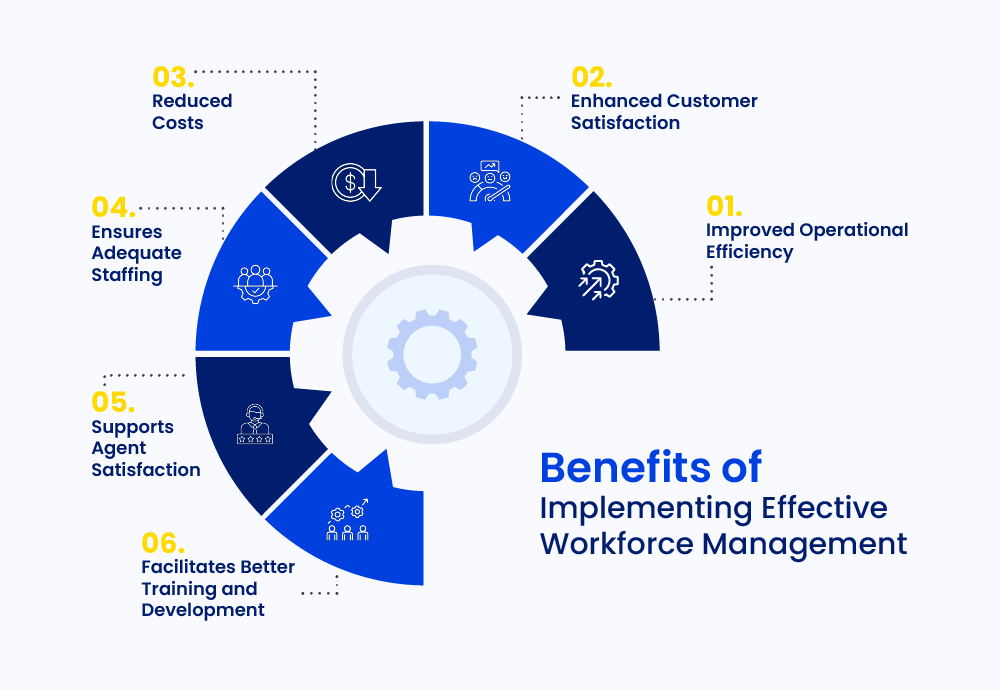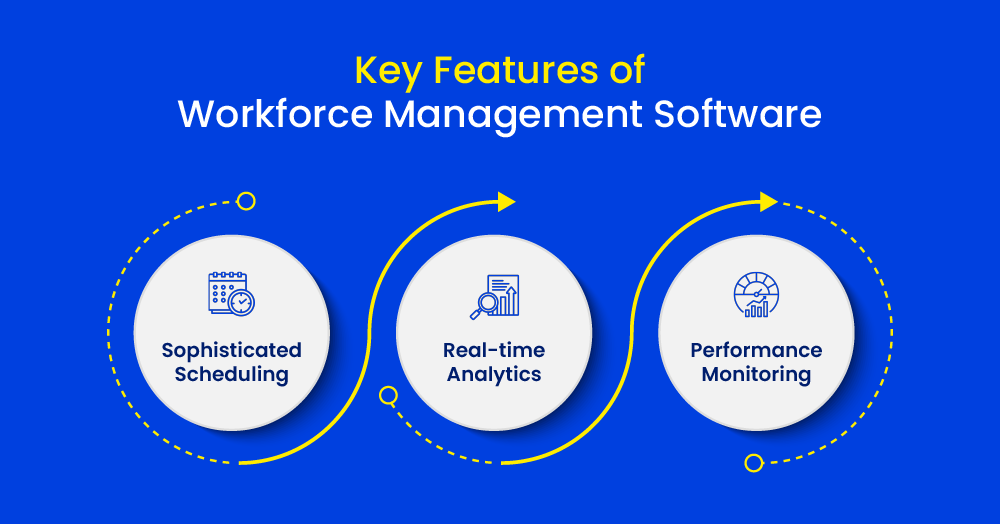Effective contact center workforce management is critical, especially in the current dynamic business environment and competitive markets. Using the right workforce management software can transform the landscape of how contact centers operate, making them more agile and responsive to dynamic market demands.
With the growing realization of streamlined operations, the thrust is more on innovative software solutions developed to handle complex scheduling, real-time decision-making, and rich analytics.
The global contact center market was valued at USD 27.32 billion in 2023 and is projected to reach USD 29.44 billion by 2024. With an expected CAGR of 8.24%, it is anticipated to grow to USD 47.57 billion by 2030. This highlights the rising adoption of efficient workforce management solutions to enhance operational efficiencies and meet customer service demands.
Understanding Workforce Management
Contact center workforce management is crucial for efficiently orchestrating the many moving parts of customer service operations.
This consists of placing the right agents at the right time with the correct skills to deal efficiently with the volume of incoming queries. This helps to optimize resources without sacrificing service quality in return.
It is not just a matter of filling shifts. Rather, it makes human resources in the contact center work more effectively. By deploying agents effectively where and when they are needed, companies can maximize operational efficiency and improve both employee and customer satisfaction.
Benefits of Implementing Effective Workforce Management
Effective workforce management in a contact center offers several advantages, which involve operational efficiency, improved customer interaction, and reduced overhead costs.
Here’s a closer look at these advantages:

1. Improved operational efficiency
Efficient workforce time management ensures that the right amount of resources is spent on agents, ensuring that they are well-utilized but not overworked.
This is directly related to better speeds and quality in customer service. Implementing Advanced Planning and Scheduling within an industry-specific enterprise resource planning (ERP) system can significantly boost operational workflows.
2. Enhanced customer satisfaction
When agents are correctly scheduled, wait times decrease, and customer interactions become more focused and personalized. The direct consequence is a noticeable increase in customer satisfaction rates.
3. Reduced costs
Organizations could reduce unnecessary labor costs and expenses due to overtime and understaffing by keeping staffing levels close to demand. For example, an AI-powered workforce management platform can drive efficiency and cost reduction by forecasting peak times, which consequently optimizes staff schedules.
4. Ensures adequate staffing
Effective workforce management prevents scenarios where there are very few or too many agents on the floor. With data-driven insights, it can predict demand and schedule agents according to demand to balance workload and workforce availability.
5. Supports agent satisfaction
With workforce management, the level of agent burnout and subsequent turnover decreases through the intelligent scheduling of work. Happy agents have more productivity and a better chance of superior customer service through a spiral toward engagement and satisfaction
6. Facilitates better training and development
Managers can detect skill gaps since they will have clear visibility into performance metrics and operational needs. This strategic development boosts individual performance and elevates the overall quality of customer interactions.
In this context, you can maximize your contact center’s potential with Leadsquared’s advanced workforce management solutions. This will enhance operational efficiency and customer satisfaction, reduce costs, and ensure optimal staffing levels.
Key Features of Workforce Management Software

Modern contact center workforce management software is equipped with powerful features developed to ease operations and drive customer service teams’ productivity.
Three key features are critical for the success of any such system:
1. Sophisticated scheduling
The bottom line of workforce management is the scheduling in place. Advanced software allows for the right staffing level based on historical data and forecasts of future call volumes, using the past as a predictor of the future. It ensures that the correct number of agents with the right skills is put in place at peak times without overstaffing during quieter periods.
2. Real-time analytics
Live feeds allow managers to make snap decisions. With real-time analytics, one can draw insights into current call traffic, agent availability, and service levels to make instant modifications to optimize performance. This feature is critical to improving the quality of service at times when there are unexpected call peaks, and staff becomes abruptly scarce.
For instance, McKinsey highlights the high impact that speech analytics can have on customer care. Analyzing speech data can lead to cost savings of 20–30%, increased customer satisfaction scores by over 10 percent, and higher sales.
3. Performance monitoring
This feature allows tracking individual and team performance through parameters such as call handling time, customer satisfaction scores, and resolution rates. It helps managers provide targeted coaching and support to achieve enhanced results.
Many contact centers are raising their service level goals from answering 80% of calls within 20 seconds to answering 90% of calls within just 15 seconds, showing a shift towards faster response times.
Challenges in Workforce Management and Solutions
Contact center workforce management faces significant challenges that can impact both operational efficiency and customer service quality.
Two such recurrent hurdles are high staff turnover and issues of scalability, both of which can be well managed by using the right software solutions:
1. High staff turnover
There are very high rates of employee turnover in the contact center domain, and this disrupts the continuity of service and also escalates training costs. The industry’s average turnover can be as high as 30-45% a year.
Effective workforce management software optimizes scheduling by ensuring staff work under conditions that are fair and predictable in terms of hours worked.
It also enhances job satisfaction by providing tools for performance feedback and career development and encouraging staff to stay longer.
2. Scalability issues
As companies grow, their customer service needs become more complex. Scalability issues range from how well a company can accommodate customer traffic during peak times to adding more locations and remote call centers without necessarily increasing management overhead.
Workforce management software helps its users by using algorithms that accurately predict demand, thereby ensuring the right level of staff preparedness.
Integrating AI in Workforce Management
One of the most transformational changes in contact center workforce management is the infusion of Artificial Intelligence. While many resources cover traditional aspects of workforce management, the role of AI in enhancing decision-making and forecasting capabilities is less commonly discussed but immensely impactful.
AI-driven tools can run through large sets of historical interaction data to accurately predict future call volumes. This allows for more precise staffing, which directly improves both operational efficiency and customer satisfaction. For instance, an AI system might predict a surge in calls based on trending topics or marketing campaigns, enabling proactive scheduling adjustments.
Studies show that generative AI could significantly boost labor productivity by 0.1 to 0.6% annually by 2040. This improvement depends on the pace of technology adoption and the reallocation of worker time to more productive activities. When integrated with other technologies, this increase could rise to between 0.5 and 3.4 percentage points per year, demonstrating the substantial impact of technological advances on productivity.
Wrapping Up
Effective workforce management is a critical element for sustaining high performance and ensuring customer satisfaction in the contact center.
By using advanced workforce management software, businesses can improve real-time decision-making, which maximizes the number of right-fit staffing levels. Therefore, reducing long-term operational costs. In today’s competitive market, staying ahead means adopting solutions that streamline processes and readily adapt to changing demands.
So, don’t let your contact center fall behind. Upgrade to Leadsquared’s cutting-edge workforce management software and transform your customer service operations.









